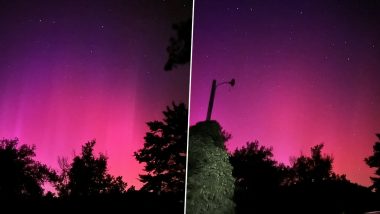Boulder, May 11: A remarkable celestial event is underway as a series of solar flares and coronal mass ejections dazzle the skies, potentially extending the spectacle as far south as Alabama and Northern California. However, alongside the breathtaking auroras, concerns loom over potential disruptions to Earth's communications networks, tonight and into the weekend, CNN reported. The rarity of this solar storm harks back to October 2003, according to the National Oceanic and Atmospheric Administration's Space Weather Prediction Center, marking a significant celestial occurrence not witnessed in many years.
Bill Nye, the Science Guy, voiced apprehension regarding the implications of the solar storm on our technologically reliant society. Drawing parallels to the Carrington Event of 1859, Nye emphasised the vulnerability posed by our heavy dependence on electricity and electronics, underscoring the potential ramifications should disruptions occur, as reported by CNN. Despite existing mitigation measures, Nye cautioned that not all infrastructure, particularly transformers, may be adequately equipped to withstand the onslaught of such a solar event, leaving room for unforeseen complications. Solar Storm Hits Earth: ‘Extreme’ G5 Geomagnetic Storm Reaches Earth, May Disrupt GPS, Power Grids.
Amidst an otherwise tranquil week, most regions of the Lower 48 States enjoy clear skies, offering prime viewing opportunities for the northern lights. However, some areas are less fortunate, with cloud cover obstructing the spectacle. From the Northeast to the Midwest, and parts of Texas and Louisiana, patches of clouds threaten to obscure the celestial display. The ongoing geomagnetic storm has escalated to an "extreme" level, rated 5 out of 5 by the Space Weather Prediction Center, marking a significant escalation in solar activity not witnessed since 2003. Northern Lights Pics: Strong Solar Storm Produces Brilliant Display of Aurora Borealis Over UK, Europe and North America, Makes it the Best Time To Watch.
This surge in solar activity manifests in the form of mesmerising auroras, illuminating Earth's poles with vivid displays of colour. However, the heightened solar activity also poses risks to communication networks, satellite operations, and high-frequency radio communications, prompting vigilance from authorities, including the Biden administration, according to CNN.
Never did I think I’d see the Northern Lights with my very own eyes in little ole Alabama, but dreams do come true.
Are there still beautiful things? Yes, yes there are. 🥹
#Auroraborealis #aurora pic.twitter.com/lXQYci2vFN
— ✨Getaway Carly✨(Taylor’s Version) in her Eras era (@Xarluna) May 11, 2024
Scientists caution that the surge in solar flares and coronal mass ejections emanating from the sun could disrupt communications on Earth well into the weekend. The sun, currently in a phase of heightened activity known as solar maximum, is expected to continue its robust performance through mid-to-late 2024. Solar cycles, characterised by fluctuations in sunspot activity, dictate the sun's behaviour, transitioning from periods of relative calm to intense activity and back again. The current cycle, Solar Cycle 25, has exceeded expectations in terms of activity, with NOAA's Space Weather Prediction Center noting an uptick in sunspot counts compared to the previous cycle's peak.
Here are some pictures of the Northern Lights from the Greensboro Police Department in North Carolina. Currently the Aurora Borealis is visible in Bryan, Texas and other cities east of IH 35 may be able to see it! pic.twitter.com/N6BwXCDsWd
— KWTX News 10 (@kwtx) May 11, 2024
This heightened activity has been accompanied by potent solar flares and coronal mass ejections, phenomena that can disrupt Earth's ionosphere, impacting communications and GPS systems with immediate effect. Additionally, spacecraft and astronauts face risks from energetic particles released by the sun, necessitating robust protection measures, CNN reported.












 Quickly
Quickly


















